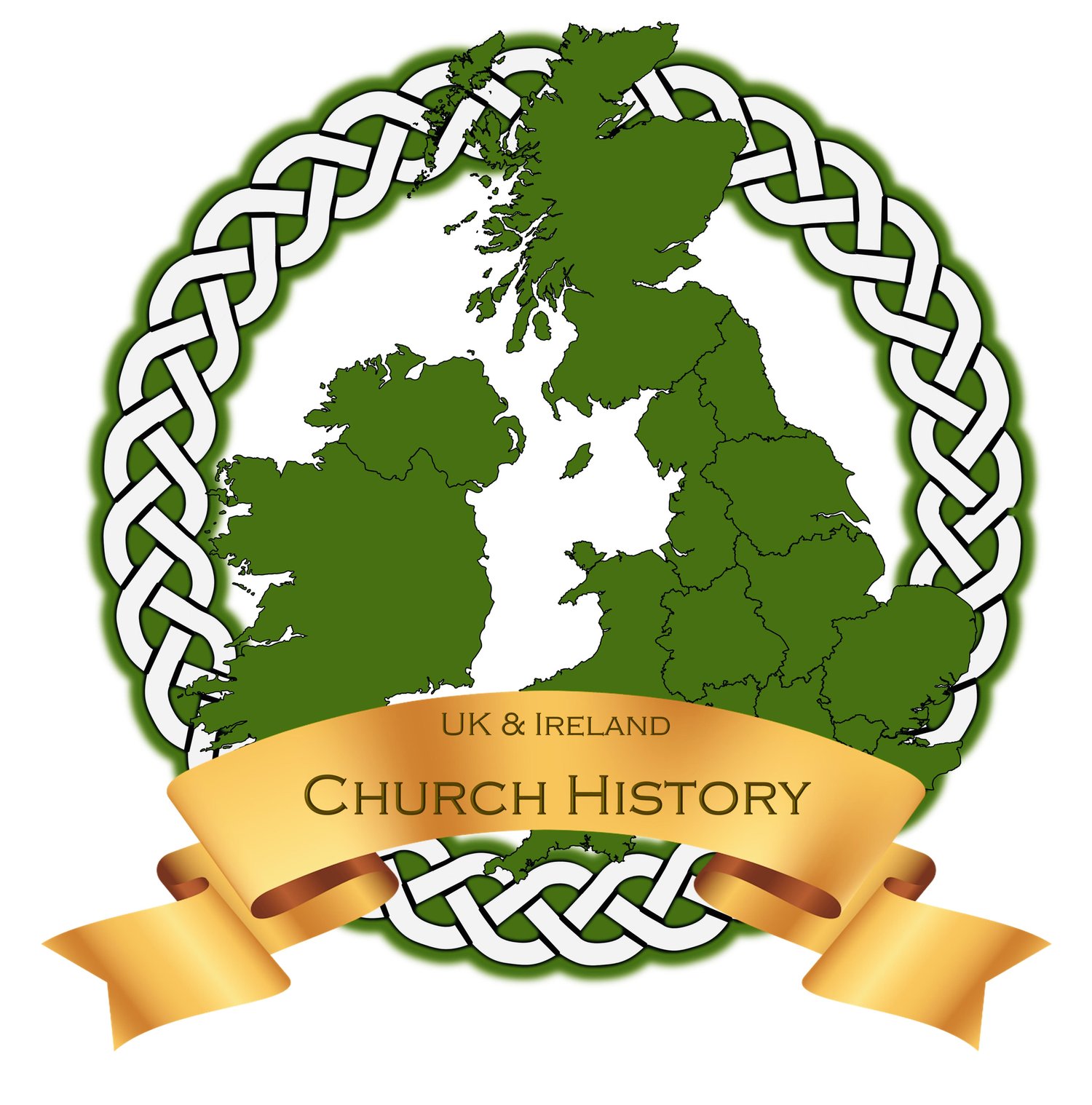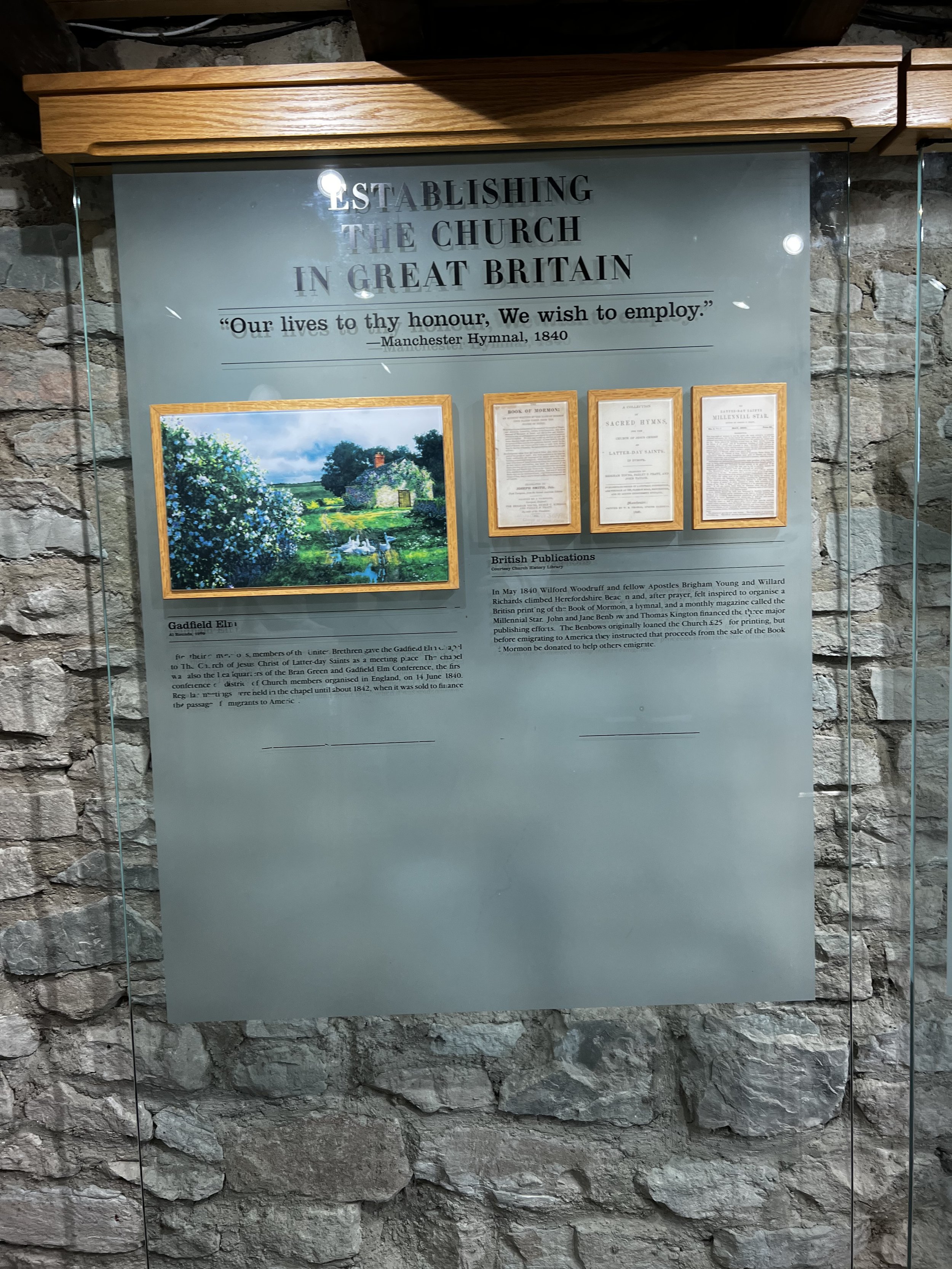Gadfield Elm Chapel Virtual Tour
Sitting quietly amidst Britain’s three counties area (Gloucestershire, Herefordshire and Worcestershire), this chapel claims the distinction of being the oldest LDS-owned chapel in the world. It is a testament to one of the greatest missionary successes The Church of Jesus Christ of Latter-day Saints has ever known.
Through this virtual tour you can visit the Gadfield Elm Chapel yourself without physically going there. Doing so will help you better understand how early LDS church leader Wilford Woodruff was able to bring multitudes of diligent seekers of truth to the Lord Jesus Christ and to His restored gospel.
After your tour, we invite you to learn more about this faith and the principles that sustain it.
The ‘United Brethren’ of Gadfield Elm
Stories of those Who Converted to The Church of Jesus Christ of Latter-day Saints from among the Gadfield Elm “United Brethren” Congregation.
Click on their photo to read more…
Levi RobertsJohn RowberryWilliam WoodJohn PerryEdward PhilipsDaniel CollettCharles PriceThomas KingstonAnn GreenJames BarnesThomas SteedJob SmithWilliam PittAnn Jewel RowleyEllen BenbowWilliam CarterThomas & Ann OakeyThomas Henry ClarkeMary Ann WestonEdward OckeyJames PalmerMary FieldJohn BenbowJohn DevreauxWilliam ParsonsMary & William JenkinsSpecial Thanks to Bernard Haw for this compiled research.
Robert HarrisGadfield Elm Chapel Restoration
The style of early non-conformist chapels
The architecture of the Gadfield Elm Chapel appears typical of the early 19th century non-conformist chapels. Its rural backroad location is typical of other non-conformist chapels. Early chapels were built outside the urban centers because leaders didn’t want to be directed by Anglican Church leaders. To distance themselves from the Anglican Church, early non-conformists specifically made their churches different. They avoided the steeples, towers, ornate architecture, and complicated facades in favor of simple rectangles that at a distance could be easily mistaken for houses. The early chapels were built specifically as preaching places and so were not focused on decoration or elaborate architecture. The simplicity of the buildings lead into the simplicity of focus of worship services. Many early chapels were basically rectangles with a gable end roof, a door and windows. They were almost always symmetrical. The pulpit would have been the focal point of the interior with a rostrum in front to accommodate a communion table and chairs. Pews were designated more for simplicity than for comfort.
The Chapel given to the Church of Jesus Christ of Latter-day Saints in 1840
Gadfield Elm Chapel was one of around 44 local preaching places that the United Brethren used for its meetings. All the others were homes of members of the United Brethren. British law of the 1800s required that all non “Church of England” religious groups register their meeting places with the local authorities. The United Brethren preachers would travel around the area and preach at these registered homes.
When Wilford Woodruff arrived and had such a great success with most members of the United Brethren, including their leaders, converting to Mormonism, there was no need for them to own a Chapel anymore. There was however a great need for Wilford Woodruff and other missionaries to have a place to preach and for members to worship together. On 14 June 1840 members in the Gadfield Elm area met together for a conference to change their organisation from the old United Brethren to the new Latter-day Saints. At this meeting, the Bran Green and Gadfield Elm branch of the Fromm's Hill Circuit became the Bran Green and Gadfield Elm Conference of the Church of Jesus Christ of Latter-day Saints. Their previous preaching places became branches. Two further conferences were held at the Chapel, one 14 September 1840 and the other on 15 March 1841 as well as many meetings.

Gallery of Degrees of Disrepair
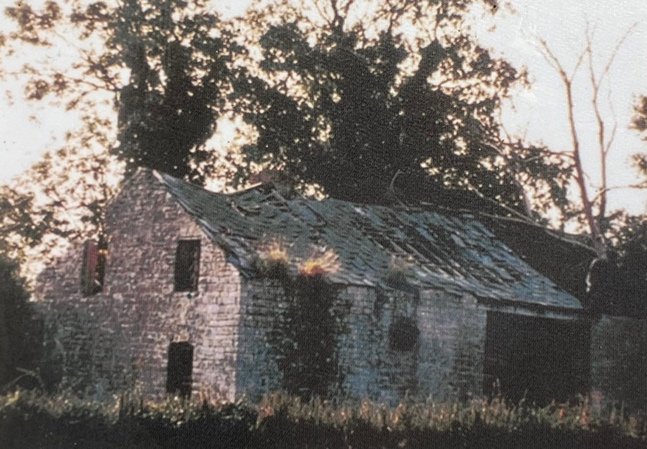
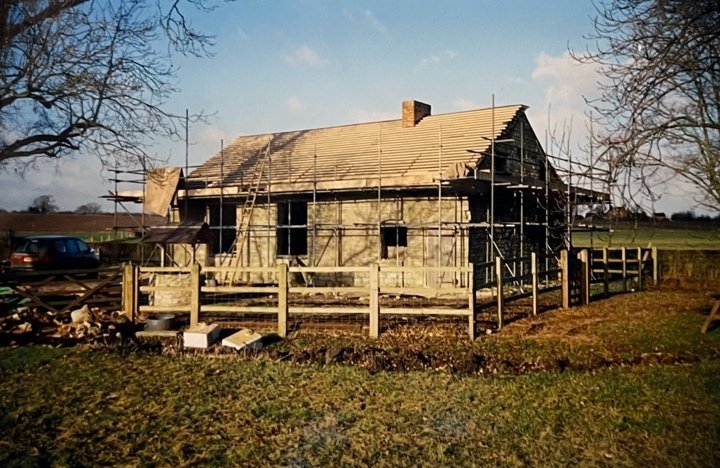
The purchase of Gadfield Elm 1994
On 12 October 1994 the Chapel and surrounding 11 acres came up for auction in nearby Eldersfield. Local members Brian Bliss, Peter Gardner and Wayne Gardner attended the auction intent on purchasing the Chapel. A local farmer wanted the surrounding 10 acres for farming so the two parties agreed that Wayne Gardner would purchase the property with the local farmer paying for the 10 acres he wanted. The farmer paid £15,000 for his 10 acres and Wayne Gardner £5000 for the Chapel and one acre. Shortly after, the Gadfield Elm Trust was organised with Wayne Gardner as chairman, Simon Gibson as vice chairman, Brian Bliss as treasurer and Ben Bloxham as historian, with intent to restore the Chapel and open it for tours. Construction work was done in phases as funds were raised.
The Gadfield Elm trust
The Gadfield Elm trust was set up in 1994 with aim of restoring the Gadfield Elm Chapel to the condition
when occupied by the United Brethren.
The Building of the Gadfield Elm Chapel in 1836
On 4 March 1836, the United Brethren, under the leadership of Thomas Kington and John Benbow, purchased a long narrow strip of land at Gadfield Elm in Eldersfield parish for £25 from a farmer, Thomas Shipton, who lived at Dobshill farm, just north of the property. The land was to be used for the purpose of erecting a Chapel and other buildings thereon for the use of the said society of the United Brethren of the Fromm's Hill Circuit. A nearby quarry west of the property provided the stone for the Chapel and several other structures in the area used this same quarry. The sandstone blocks were cut and brought to the site and a slate roof was put on. The Chapel was completed in early 1837 and registered as a religious meeting place on 27 May 1837. The large room at the Gadfield Elm Chapel was used for preaching and held about 100 people. The smaller areas in the building may have been used for circuit for council meetings or smaller preaching settings.
The Gadfield Elm Chapel after 1841
In 1841 as the apostles were preparing to leave England, discussions began about what to do with the Gadfield Elm Chapel. As more converts from the area immigrated to Nauvoo, it became apparent that Chapel wouldn't have much use as the Latter-Day Saint meeting place. The Chapel was sold, and money used to finance passage of members to America and to offset costs of the British mission. It is unknown when it was sold, who bought it and how much was paid.
By 1859 the Chapel belonged to Guy Hill of Old Rock, Dimmick, who was a farmer and Joseph Alan Higgins of Ledbury who was a lawyer. In 1859 Guy Hill and Joseph Alan Higgins sold the narrow strip of land the Chapel was on to the Caleb Trapnell family. The Trapnells owned the Chapel until 1931 when it was sold to the Parsons family. The land the Chapel was on came into the ownership of the Cole/Bacon family in the 1970s. In 1994 the Gadfield Elm Trust purchased the Chapel from Edna Joan Bacon.
A neighbour remembers his father storing farm equipment in the building when he was a child in about 1920. It was also a livestock holding pen at one point. A German, named Bill Krazel, lived there with his family in the 1950s and 60s for about 12-year period. He maintained the building in a good condition and added the concrete render to the interior walls that can be seen in old photographs of the building. After the Krazel family moved out the building again fell into disrepair. At some point most of the north facing wall was destroyed. Stones were removed, mostly from the north facing wall for use in nearby gardens. By the time the Chapel came up for auction in 1994, it was not in a good condition. The roof was almost completely gone, and several walls were very unstable. A large tree was growing through the centre of the Chapel. Enough of the Chapel was left however to act as a guide to restoration.
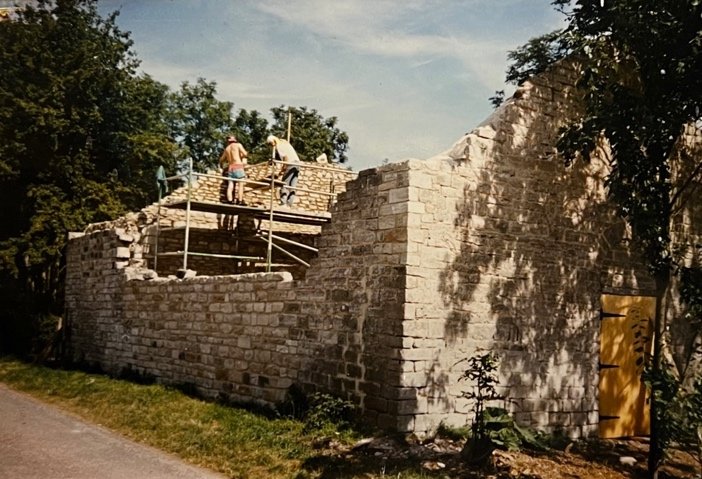
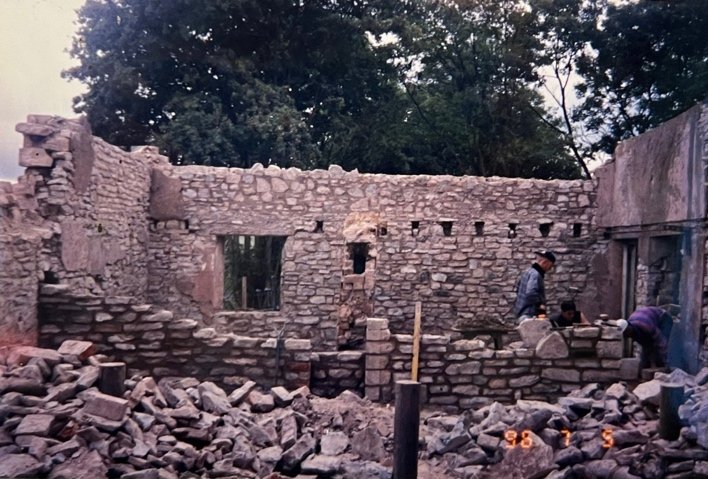
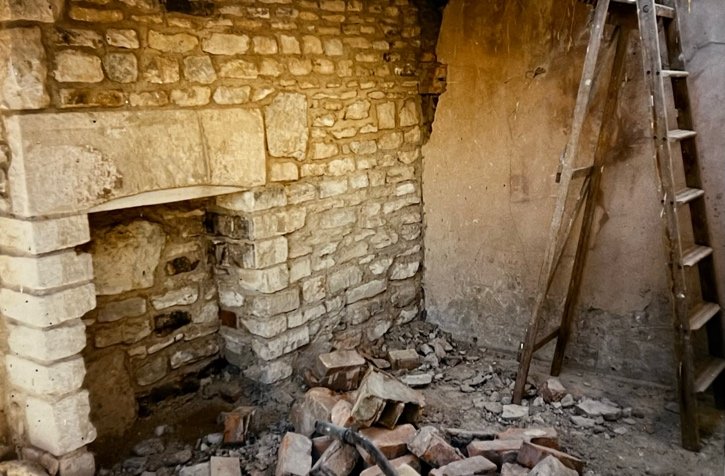
The Restoration of Gadfield Elm Chapel
The first phase of the restoration was to clear the site of all undergrowth and brambles and stop further deterioration of the walls. Much of this work was carried out by members of the local Wards and Trust members. Work finally started with Paul Woodhead, a builder, being contracted to rebuild the stone walls of the Chapel. The walls were unsafe, there was no integrity left in them, they were shot, either water damaged at the foundation level or they were leaning and clearly a new roof could not be erected on the existing walls. It was decided to map the stones as they were removed so that every level was numbered. As a layer of stones was removed, it was laid flat on the ground. Then the next layer was laid flat on the ground, and so on. So it was built up exactly as it was originally. Where necessary, foundations were checked and fixed. Then starting with the nearest layer of stones the walls were built back up again in exactly the same order and inserting the windows.
Some of the stones were missing from the building. Luckily, there was a dilapidated barn about 100 yards from the Chapel built of stone from the same time period and the same quarry. The trust purchased some of that stone from the farmer who owned the barn, and work on rebuilding the Chapel began.
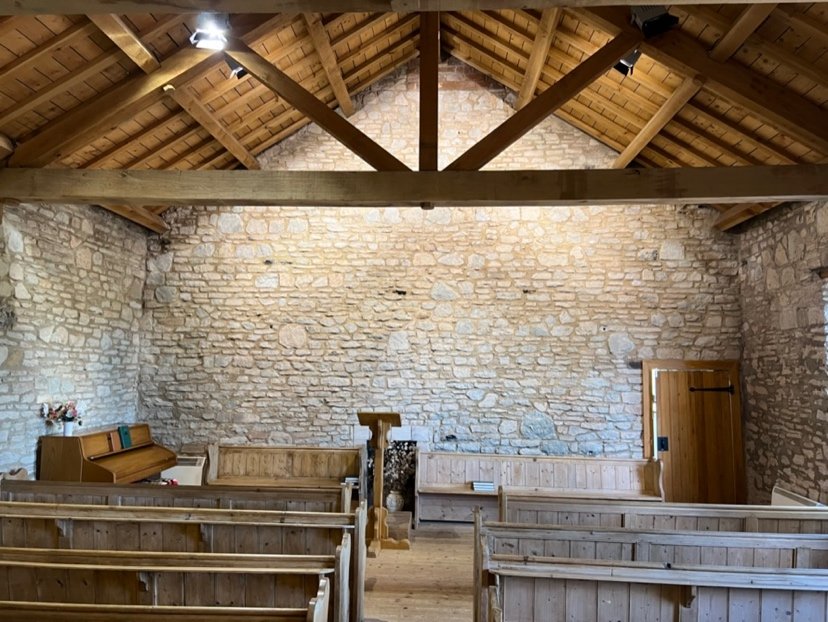
The Roof - Once the walls were up, church headquarters became involved and made a donation which helped pay for the new roof. Mike Tate was contacted for the building of the roof which was carried out using hand tools.
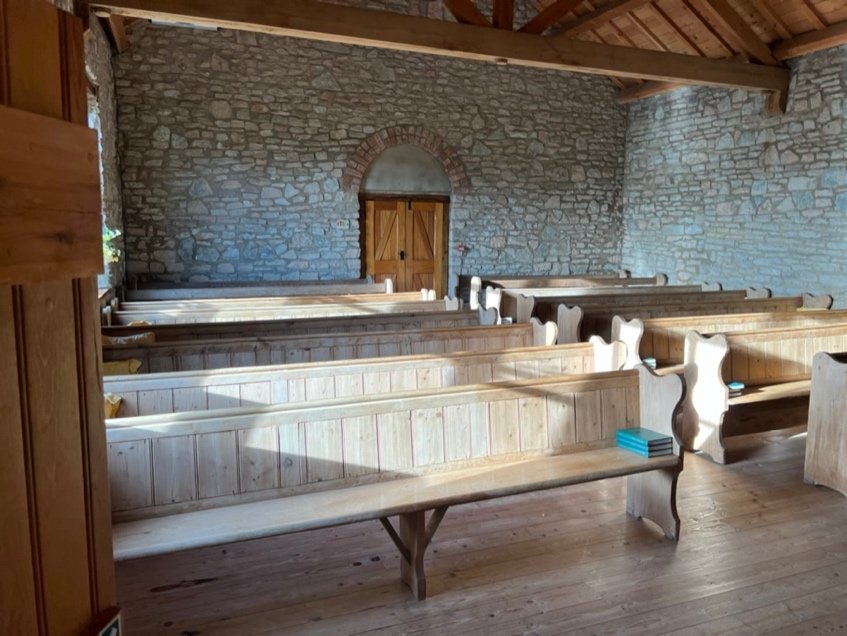
The Pews - When the trust located a scrap merchant in Wales who specialised in church scrap, and he had just cleared some pews out of a non-conformist Chapel in Wales. The pews were from the same time period as the original Gadfield Elm Chapel. The trust purchased the pews, and they were sanded down to retain their rustic appearance yet enhance the comfortableness.

The Well - The old well outside was also restored and provided the water supply to the building. The whole project was completed in time for the new Millennium.
23 April 2000 - Jeffrey R. Holland Dedicates Gadfield Elm Chapel
Elder Jeffrey R. Holland dedicated the building on Easter Sunday, 23 April 2000. Around 250 people attended the dedication, many of them waiting outside because the Chapel seats only about 100. Elder Holland arose to speak and expressed what an emotional day this was for him. Having spent seven years serving the church in England, he was extremely grateful to be given the opportunity to return for this special occasion on Easter Sunday. He mentioned that he had visited the site 15 years ago when he was an Area President, and the Chapel was an overgrown ruin. He said that this was not just an ecclesiastical privilege but also a personal one since Ellen Benbow of Castle Fromm and William Carter of Ledbury who were married in Nauvoo Illinois were his first ancestors.
26 May 2004 - Gadfield Elm Chapel given back to the church and dedicated by President Gordon B Hinckley
The deed to the historic 1836 Gadfield Elm Chapel in England, oldest existing building in the church, was presented to President Gordon B. Hinckley on 26 May 2004. In a ceremony in the small Chapel located in the quiet countryside of Worcestershire, President Hinckley stood where other luminaries in church history must have stood as they preached the message and doctrines of the restored gospel of Jesus Christ, including missionaries who are among his predecessors as Presidents of the Church.
During the ceremony at the Chapel, Wayne Gardner, a representative of Gadfield Elm Trust, turned over to President Hinckley the keys and deed to the Chapel. Receiving the Chapel on behalf of the church, President Hinckley paid tribute to those who had the foresight to acquire it and to restore it. He went on to say they would have unending gratitude of the people of this church. That this is the oldest Chapel the church has anywhere in the world and was in use by the church before it had built anything in America. It was the effort that was made here that in reality saved The Church, President Hinckley said…
